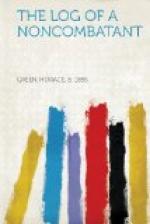At the same time it is true that because of the tortures endured by the Belgian people, because of the pain and horror of the war of invasion, much of it unavoidable, the American public, because its sentiment is so strongly anti-German, has been willing to believe anything of the race against whom runs its prejudice. Truly remarkable is the rapidity with which atrocity stories have been created and the relish with which they are swallowed by drawing-room gossips. Those who have seen the war do not find it necessary to talk about what does not exist. Mr. Arthur Ruhl, who has seen and carefully studied all sides of the war, applies the term “nursery tale” to the average atrocity story. Mr. Irvin Cobb, John T. McCutcheon, and others who have been on the ground also took them with a grain of salt. Curiously enough, the closer one got to the actual fight, the less bitter was the feeling between participants, the greater their respect for one another, and the less credulous their belief in the enemy’s barbarity.
An American who was recently discharged from seven months’ service with the British army tells me that during this time the only knowledge he had of personal atrocities was through the British and French newspapers. And there are well-known stories of opposing trenches so closely situated that the soldiers taught each other their respective national airs, and the choruses of their camp tunes.
To return to another form of alleged outrage, we have the ancient argument on the case of Rheims.
An interesting contribution to the testimony has been given by Cyril Brown, now special correspondent of the New York Times in Berlin. Brown made his way to the German army lines before Rheims, where, among others, he interviewed First Lieutenant Wengler, of the Heavy Artillery, commander of a battery which shelled the church spire, but known among his comrades as “the little friend of the Rheims Cathedral.” According to Lieutenant Wengler two shots only struck the church spire (one from a fifteen centimeter howitzer, another from a twenty-one centimeter mortar) and this after French observers had used the tower for five days between September thirteenth and eighteenth. So sparing was this young “barbarian,” in spite of provocative fire obviously directed from the French cathedral, that “the friend of the Rheims Cathedral” stuck to him as a nickname.
In America Brown’s statement provoked a storm of retort. Allied correspondents claimed that a dozen shots at least crashed through the roof, set the scaffolding ablaze, and that, at a time when Red Cross flags were floating from the tower and red crosses were painted on the roof, shells continued to devastate the beautiful interior, etc., etc. There has been a quantity of discussion back and forth as to the number of shots fired. Now, so far as the question of atrocity is concerned, though every one will regret the ruin of this noble work of art, I hold that it is not of the slightest importance whether there were fired two shells or seventeen or seventy-seven. The important and only question at issue is, whether the tower was used for observation purposes, or, in other words, was there military justification for its attempted destruction?




